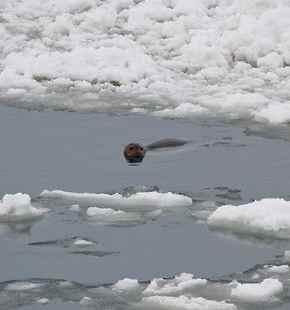The NY Times is hosting a field journal by Kate Stafford of the University of Washington, as she recounts her work as part of a team surveying for bowhead whales along Alaska’s north slope. This recent post is a marvelous evocation of the soundscape of spring in those northern seas. You should definitely go read the whole thing (there is an absolutely beautiful extended audio clip of a chorus of bearded seals, bowheads, and belugas, as well as shorter clips of each individually), but here are some teasers:
You can look across a vast expanse of ice, all white and blue and cold, and see nothing. The lead is choked with pack ice or sealed over with newly formed ice, and there is no movement or sound. With few birds, no whales and no bears, one might mistake the Arctic for a desert. But if you go down to the ice edge, pick a hole in the new ice deep enough to reach water and drop in a hydrophone (an underwater microphone), the cacophony is astonishing.
What I have come to enjoy just as much as listening is passing the headphones to someone who has never heard springtime in the Arctic. It is a rite of spring that would stun even Stravinsky.
Here in the Chukchi Sea the springtime soundscape is dominated, always, by the long trills of male bearded seals….Though we have seen only one or two bearded seals off Barrow, it is clear from the acoustic data that there are many of them trilling all at once and within only a few kilometers of the perch. (the photo, by Kate Stafford, is of one of the bearded seals that showed itself)
The low frequencies used by bowhead whales overlap the acoustic bandwidth in which large ships and oil and gas exploration produce sound. These manmade sources of noise are likely to increase background noise levels as summer sea ice continues to decline and shipping routes cross the Arctic during ice-free summers. It is possible that this increase in noise will affect bowhead whales in particular by causing them to change the frequencies they use to communicate or the duration of the calls they produce, or by restricting the ranges over which they communicate.


June 3rd, 2011 at 4:19 pm
Related to this, Beam Ranch offers a 10-week Marine Biology course that seems great for students seeking off-campus study credit: http://www.beamreach.org/?ceca5/28/2011
Its emphasis is Bioacoustic study of the southern resident killer whales (orcas).